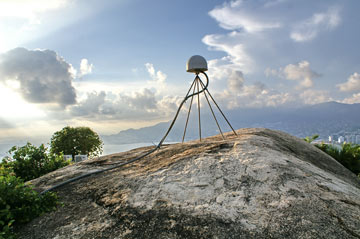|
NEWS NOTES
Seismology
Plate reversal not easing threat of earthquake
 Vladimir Kostoglodov |
| A reversal in plate tectonic motion in Mexico didn’t reduce the threat of a major earthquake in that region. A network of GPS receivers, including the one pictured here, recorded the event. |
Last year, a section of the southwestern coast of Mexico in the state of Guerrero, which normally moves slowly northeast on its tectonic plate in the direction of Mexico City, did an about-face: It started heading in the opposite direction toward the Pacific Ocean for several months before returning to its regular trajectory. This reversal in tectonic plate motion — called a slow slip event — is the largest one ever identified, and it does not appear to have alleviated the threat of a major earthquake in the region, researchers say.
Guerrero, home to resorts such as Acapulco, sits along the subduction zone where the Cocos Plate normally slides under the North American Plate at a rate of about two centimeters per year, and seismic stress builds up along the fault until released periodically through earthquakes. Beginning in the spring of 2006, GPS receivers in the region recorded a slow slip event in which Guerrero started to move in the opposite direction, displacing a total of six centimeters over the course of just six months, Kristine Larson of the University of Colorado at Boulder, Vladimir Kostoglodov of the National Autonomous University of Mexico in Mexico City and their team reported Aug 1. in Geophysical Research Letters.
Slow slip events were unknown until about a decade ago, when geologists established networks of GPS receivers to record movements in Earth’s crust. “GPS allowed people to measure plate tectonics in real time,” Larson says. Before GPS, geologists assumed the movement of plates was constant between earthquakes, she says. In 1998, however, Larson discovered this was not the case when analyzing data from a lone GPS receiver that Kostoglodov and geologist Roger Bilham had set up in Mexico. Puzzled by the data, Bilham and Kostoglodov sent them off to Larson, a specialist in GPS. “I was also perplexed,” Larson recalls. The data showed that the region near Acapulco was reversing its direction, which was not supposed to happen, she says. Soon after that, published reports of similar events in Japan and the Cascadia region of North America convinced Larson that what she was seeing was a real phenomenon, not a glitch in the data.
Slow slip is motion along a fault that is faster than normal creep, but too slow to produce seismic waves, says Herb Dragert of the Geological Survey of Canada, who studies slow slip in Cascadia. These events occur over a period of hours, weeks, or, as the new research shows, months. But why this happens is still not known. Such events are interesting to geologists, he says, because of the effects they may have on the likelihood of a major earthquake striking. “Perhaps by looking at slow slip,” he says, “we can narrow down a more specific time window when the probability of an earthquake is greater.”
Geologists think slow slip events could reduce the threat of an earthquake by gently releasing some of the stress that builds up along the fault so that not enough can accumulate to trigger a major earthquake, but that does not seem to be the case in this instance. The slip in Guerrero occurred much deeper than the part of the fault that ruptures during an earthquake, Larson says, suggesting it had no effect on the stress building up. Regardless of whether or not slow slip events make earthquakes less likely — or perhaps even more likely — studying them is important because they have shown that we need to reassess how we think about plate tectonic motion and our understanding of seismic risk, Larson says.

 Subscribe
Subscribe


